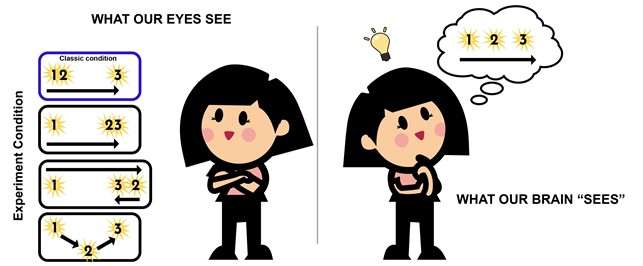We at IFLScience love an illusion (as apparently does Mars). So, naturally, we were thrilled to hear about a new twist on the visual rabbit illusion – also called the visual saltation illusion.
Typically, the illusion involves two dots flickering in quick succession at one point and a third dot flashing at a different location. Thanks to our dumb brains, we tend to perceive the second dot as midway between the other two in our peripheral vision, which, of course, it isn’t. This gives the effect of the flash jumping, as if it were a rabbit hopping – hence the name.
In a recent study, researchers from Kyushu University present a novel take on the illusion, changing the location of the second flash to see if that shook things up. In their versions, the second dot appears either in the same position as the third flash, out of sequential order, or out of linear alignment with the first and last flashes.

The researchers altered the position of the second flash to see how it affected the perceived illusion.
Image credit: Hector Palomo/Kyushu University
In all three scenarios, when the three flashes were presented in quick succession, participants misperceived the second flash to occur close to the midpoint between the first and last.
“It’s like a rabbit hopping back to the middle after the brain processes it,” Sheryl Anne Manaligod de Jesus, first author of the study, said in a statement.
Essentially, it doesn’t matter where that second dot actually is, our brains are adamant it should be in the center, even when it clearly isn’t.
Think you’ll fare better than the test subjects? You can check out the team’s version of the illusion below, just focus your eyes on the cross.
Technically, the first flash appears to the left, and the second and third flashes are at the same spot to the right, but we’re willing to bet that’s not what you saw.
So, what’s going on? When our visual system receives flashes in rapid succession, like this, the brain processes them together, which causes a perceptual reorganization of the flashes into a more logical pattern.
“Perceiving the second flash closer to the midpoint is the average position of where the brain believes it should be,” the team write in their study. “Crowding combined with higher speed presentation of the second flash are not typical stimuli our eyes receive on a day-to-day basis. As there is a lack of ‘prior’ knowledge of such stimuli, the flashes are reconstructed into a pattern that makes sense.”
Basically, our brains are tricksy things, and attention and memory can disrupt what we “see”.
“Our brain sometimes uses future events to interpret the past,” says de Jesus, “This is called postdiction, meaning that how we perceive a past event, like the second flash, is influenced by what happens afterward. This results in the fascinating illusion of the flash appearing in a place, where it never really was.”
And if that hasn’t bent your mind sufficiently out of shape, check out some more trippy illusions below:
The study is published in the journal i-Perception.
Source Link: The Visual Rabbit Illusion: Scientists Invent Trippy New Take On Classic Illusion